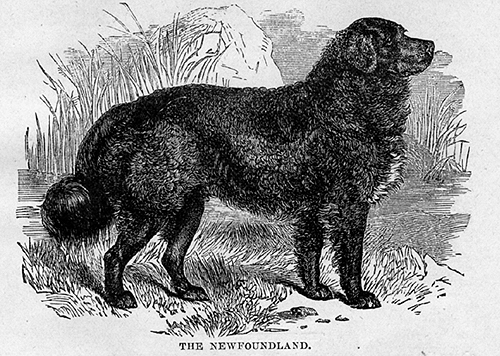[ Murray / The Dog in Health, Habits and Disease ]
Bromley Murray (1863 - 1934).
This 1886 volume — the subtitle of which is "a complete guide to all breeds and their successful management. Containing, in addition to personal experience in teachings, the best methods of Vero Shaw--Mayhew--Richardson--Youatt, together with a glossary of terms as applied to the dog" — is both an overview of dog breeds — a mini dog encyclopedia, basically — and a manual of treatment for various dog illnesses and conditions, all packed into 107 pages! There are woodcut illustrations of most of the listed breeds, as well as a few other illustrations (such as of muzzles and splints). This book's first, and apparently only, publication was in 1886 (Philadelphia: R. C. Hartranft).
The complete discussion of the Newfoundland follows the illustration:

The Newfoundland dog is of two distinct breeds, the large and the small, the latter being also called the St. John or lesser Labrador. The former is the most common in this country, and is a dog of massive form, possessing great character and intelligence. In Newfoundland he is used as a beast of draught, being harnessed to sledges, which his great form, large feet, and endurance enable him to draw over the snow, while his thick coat and hardy constitution render him little amenable to the effects of cold and wet. As a water dog he has no equal, and he floats or swins [sic ] for hours without suffering from the immersion. His patronage of children, especially when in danger of drowning, is one of the most remarkable features in the canine race, and the way in which he suffers himself to be pulled about by them makes him, when not exceptionally ill-tempered, the pet of many a family. Still it will not always do to trust him, and I have known many examples which were absolutely dangerous even to their masters when excited by deprivation of food or anger against some offender of their own species.
The Head is remarkably grand and full of character, with an expression of mildness and benevolence, shared with this breed by the St. Bernard. Across the eyes the breadth is great with a flatness behind them, before which the skin is wrinkled, but without any perceptible forehead. Eyes small, bright, and intelligent, deeply set, but not showing the haws, and give the appearance of being bloodshot, so remarkable in the bloodhound. Ears small and set low, hanging close to the face, and with little hair on them. Nose large, muzzle long and smooth; mouth capacious with level teeth. Neck shorter than in most breeds. Points: Head, 30; temper, 20; neck, 10. Back often weak and slack in the loin, but this is a fault which, though common, is not universal. There is also very often a want of depth in the back ribs which ought not to be passed over. Back and loin, 10. Feet and Legs large and muscular, the former being too flat for much work over hard ground, and are more adapted for the snow of his native land, or for swimming. Feet and legs, 10. Color black, or black and white, the former greatly for choice, with as little white as possible. Sometimes the black has brindled legs, or of a reddish dun color, and occasionally full bred dogs are met with brindled, or reddish dun mixed with white. There are several varieties in texture of coat. The smooth dog is almost as free from any approach to feather as a mastiff. If this dog has any tendency to feather, it will declare itself in profile just below the set-on of the head. His coat, if well examined, will be found more dense than a mastiff's, and of greater volume.
The shaggy-coated Newfoundland has a smooth face, but within two inches of the skull the coat suddenly elongates, and except that he is very clean to the ankle of his neck, he is thoroughly feathered in his outline. His coat generally parts down the back, and this parting is continued to the end of his tail, which is bushy and carried very gaily. His hind legs are close-coated from the hock, and his feet all round are nearly as free of feather as a cat's.
The Stern is long and bushy, usually slightly turned on one side, and carried in a trailing fashion. The gait is rather loose and waddling, but this is a defect owing to the slackness of loin. Carriage, 5; stern, 5. In height this dog is sometimes 33 or 34 inches, averaging 29 or 30.

